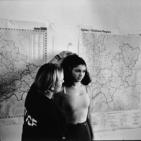Crossing the Line
dal 26/5/2003 al 20/7/2003
Segnalato da
Chantal Akerman
Marjoleine Boonstra
Ad van Denderen
Jacqueline Salmon
Teun Voeten
Piet den Blanken
Ingrid Simon
Miriam Bestebreurtje
Lucas Gehrmann
26/5/2003
Crossing the Line
Kunsthalle Wien Project Space, Wien
Using artworks (photography, video, installation), the exhibition Crossing the Line will primarily pursue the question of why things happen. In tracing the structures of 'human trafficking,' the artists invited explore the links between political, ethnic and aesthetic matters in a variety of ways.

Human trafficking
Participating artists: Chantal Akerman, Marjoleine Boonstra, Ad van Denderen, Jacqueline Salmon, Teun Voeten, Piet den Blanken, Ingrid Simon
On the occasion of the Netherlands' chairmanship of the OSCE (Organization for Security and Co-operation in Europe) this year, the Kunsthalle Wien is presenting an exhibition in cooperation with the Netherlands Photo Institute that deals with one of the OSCE member states' gravest problems: illegal migration, combined with the smuggling of and trade in human beings.
The public usually receives information regarding this issue from the media, whereby the images shown mostly document what has happened in very special instances. Using artworks (photography, video, installation), the exhibition Crossing the Line will primarily pursue the question of why things happen. In tracing the structures of 'human trafficking,' the artists invited explore the links between political, ethnic and aesthetic matters in a variety of ways. Here 'documentation' is only one aspect of numerous possibilities for artistic involvement in socially relevant issues. Documenta 11 organizer Okwui Enwezor's formulation of the definition of art as 'something useful to the production of knowledge' is certainly applicable to the artistic positions exhibited.
Belgian artist Chantal Akerman will show the work From the Other Side (2002): In an installation of 18 monitors she shows the different stages of human trafficking on the border of Mexico and the USA. The presentation is separated in three parts, following the path of the migrants: From the first row of monitors where the men and women hoping 'make the jump' talk about their backrounds and reasons, through images of the people that enable the smuggling, to a single monitor where we see how this journey mostly ends: in arrest and deportation by the boarder patrol. Akermans installation is both a documentary work and an aesthetic sculptural object that invites the viewer to partake in the experience of the people involved. The monitors not only show the content of the story by its documentary content but also in its aesthetic rendering: coloring and standpoint transmit the different phases of the perilous journey.
Dutch photographer Ad van Denderen has followed the plight of many men and women who have tried to enter Europe, and espacially the Schengen area, over the last 16 years. This year he shows an extensive selection of his work for the first time as a coherent series: GoNoGo. In this work he concentrates on the effect illegal migration has on the individuals that undertake it. He investigates how people leave the relative security of their homes to run extraordenary risks and give themselves up to the mercy of what they often know to be, ruthless people to find a better life. Van Denderen chronicles the day to day truth of this modern form of slavery: no rights, constant fear of detection, loss of privacy.
He presents his work together with the work of dutch documentary director and photographer Marjoleine Boonstra who made film-portraits of a group of people namely people who tried to cross into Great Britain from the French coast and got interned in the Red Cross shelter of Sangatte.
French artist Jacqueline Salmon has visited this same hangar in Sangatte where illegal immigrants who tried to cross the Channel from France to Great Britain and failed, are interned. In an extensive series of color stills she shows their backgrounds and circumstances in a detached way. The bare minimum in hospitality that is offered to these people and their desperate attempts to create some kind of personal space are depicted in large color images. Kunsthalle Wien will show 7 large images, not of people but of their surroundings in Sangatte.
Dutch antropologist and photographer Teun Voeten has photographed, in often difficult endeavours, young Moldavian women who are traded to clubs and brothels on the Balkan. They live their lives as modern day slaves in what turns out to be a growing industry in this part of the world. In a series of 10 black and white images Voeten shows how women that flee poverty end up in far worse conditions.
Ingrid Simon's project Present Continuous presents color images of the clothes people have hastily left behind after swimming off from the coast of Puglia. Simon combines the images of the discarded clothes, diapers or shoes, with texts that seem to refer to language courses. The chaos of the traces of illegal goings on are set off by the order and structure of human interaction that is suggested in the system of a language course.
Piet den Blanken has, as a photographer, visited the many 'hotspots' of the European border, Istanbul, the Greek Isles, the Spanish enclave Ceuta in Northern Africa. His images of the nightly controls of the rickety boats holding people who try to make the crossing on the Mediterranian sea, will be projected within the project space at night.
Opening: Tuesday, 27 May, 2003, 7 pm
The exhibition is presented in cooperation with the Netherlands Photo Museum and the Permanent Representation of the Kingdom of the Netherlands to the OSCE.
With friendly support by the Mondriaan Stichting, Amsterdam.
Curators: Miriam Bestebreurtje, Lucas Gehrmann
A catalog published in conjunction with the exhibition will include texts by Jaap de Hoop Scheffer, Helga Konrad, Miriam Bestebreurtje, Fritz Gierstberg et al.
Information and photographic materials: Claudia Bauer, KUNSTHALLE wien, office: Museumsplatz 1, A-1070 Vienna, phone. +43-1-521 89-1222, fax +43-1-521 89-1220
Location: KUNSTHALLE wien project space karlsplatz
Treitlstraße 2, A-1040 Vienna
daily 1pm - 7 pm
Infoline +43-1-52189-33



